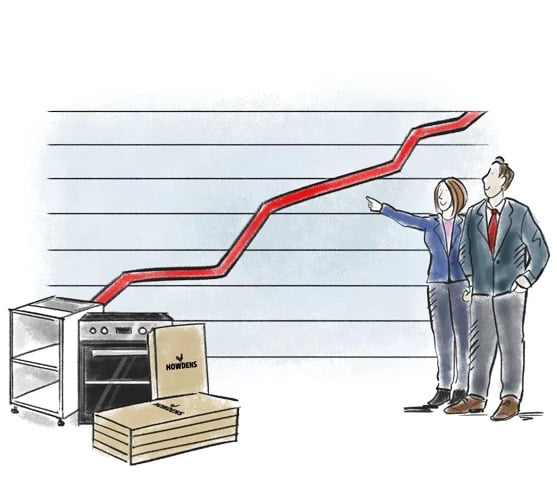2011 Half Yearly Report
21 July 2011
The information presented in this document relates to the 24 weeks to 11 June 2011 and the 24 weeks to 12 June 2010, unless otherwise stated.
Highlights
Chief Executive, Matthew Ingle, said:
"We are pleased to have increased sales and profit in what are demanding market conditions. This performance is testament to the strengths of our business model and the efforts of all our staff. It also gives us confidence to continue to invest in the long term growth of the business.
"We expect market conditions to continue to be challenging for the rest of the year but remain confident about our performance, which is in line with our expectations for 2011."
Financial results
- Howden Joinery UK depot revenue increased by 4.9% to £334.9m, up 2.4% on a same depot basis. Sales in the last three periods (since mid-March), during which prices were unchanged from 2010, were up 3.7%. Group revenue was £341.7m (2010: £324.7m);
- Gross profit margin rose from 58.1% to 59.3%;
- Operating profit increased to £25.5m (2010: £24.5m);
- Profit before tax rose by £1.9m to £23.5m (2010: £21.6m);
- Basic earnings per share increased to 2.8p (2010: 2.3p);
- Net cash of £5.1m at 11 June 2011 (25 December 2010: £35.0m net cash, 12 June 2010: £2.7m net debt), after payments totalling £17.2m relating to legacy properties and a payment, in excess of the operating charge, of £17.9m to the Group's pension schemes (the 'pension deficit contribution').
Business developments
- Investment in the future growth of the business continues:
- new products introduced across whole spectrum of offer;
- five new depots opened so far in 2011, bringing total to 494;
- capital expenditure totalled £7.9m;
- orders placed for new cabinet production lines at Runcorn and Howden.
- Further mitigation of legacy property liability, with termination of leases on four more legacy properties since the Interim Management Statement, bringing the total so far this year to 12.
Current trading
- Howden Joinery UK depot total revenue increased by 10.5% in the first period of the second half of the year (period 7) compared with the same period last year - this included the benefit of a price rise being initiated and some associated pull-through effect on sales.
- Management's expectations for the year remain unchanged.
Enquiries
| Enquiries | ||
| Investors/analysts: | Media: | |
| Gary Rawlinson | Brunswick: | Kate Holgate |
| Head of Investor Relations | Kate Miller | |
|
+44 (0)207 404 5959 (21 July 2010 a.m. only) |
+44 (0)207 404 5959 | |
| +44 (0)207 535 1127 | ||
| +44 (0)7989 397527 | ||
Note for editors:
Howden Joinery Group Plc is the parent company of Howden Joinery. In the UK, Howden Joinery is engaged in the sale of kitchens and joinery products to trade customers, primarily small local builders, through 494 depots. Around one-third of the products it sells are manufactured in the company's own factories in Runcorn, Cheshire, and Howden, East Yorkshire. The business also has a small operation in France.
SUMMARY OF GROUP RESULTS
| £m unless stated | 2011 | 2010 |
| Revenue - Group |
341.7 | 324.7 |
| - Howden Joinery UK depots | 334.9 | 319.2 |
| Gross profit | 202.8 | 188.8 |
| Gross profit margin, % | 59.3 | 58.1 |
| Operating profit | 25.5 | 24.5 |
| Profit before tax | 23.5 | 21.6 |
| Basic earnings per share | 2.8p | 2.3p |
| Net cash/(debt) at end of period | 5.1 | (2.7) |
FINANCIAL REVIEW
FINANCIAL RESULTS FOR FIRST HALF OF 2011
The financial results of the Group during the first half of 2011 benefited from the Group's competitive position and actions taken to improve performance.
Total Group revenue increased by £17.0m to £341.7m.
Revenue £m |
2011 |
2010 |
| Group | 341.7 | 324.7 |
| comprising: Howden Joinery UK depots Howden Joinery French depots |
334.9 6.8 |
319.2 5.5 |
Howden Joinery UK depots' revenue rose by 4.9%, increasing 2.4% on a same depot basis. Looking at the three periods since mid-March, which taken together are not distorted by the different dates of Easter, total sales increased by 3.7%. This was achieved without the benefit of a price increase in the first half of 2011.
In demanding market conditions, this growth has been achieved through a number of factors. The value of kitchen (furniture, worktops, sinks & taps, appliances) sales has risen partly as a result of a higher proportion of sales from mid and higher priced ranges. Also, the value of door sales has increased as the mix has changed and the volume of sales of joinery and flooring has increased substantially. In addition, revenue until March of this year benefitted from the price increase implemented in March 2010.
Sales by our French depots of £6.8m were up over 20% in constant currency terms.
Gross profit rose by £14.0m to £202.8m, the gross profit margin rising from 58.1% in the first half of 2010 to 59.3%.
Selling and distribution costs and administrative expenses increased by £13.0m to £177.3m. This reflects the costs of new depots, additional staffing in existing depots, increased marketing expenditure and the impact of inflation, particularly on payroll costs.
Operating profit increased by £1.0m to £25.5m.
The net interest charge fell by £0.9m to £2.0m, reflecting the reduced finance expense in respect of pensions. The net result was that profit before tax from continuing operations rose by £1.9m to £23.5m.
The tax charge on profit before tax was £6.5m, based on the estimated effective rate of tax on profit before tax for the 2011 financial year of 27.6%. This tax rate reflects the impact of depreciation on capital expenditure that is not allowable for tax purposes and other non-deductible expenditure.
Basic earnings per share were 2.8p (2010: 2.3p)
At 11 June 2011, the pension deficit shown on the balance sheet was £110.8m (25 December 2010: £135.7m). The decrease in the deficit in the period was mainly driven by the Company's contribution (£17.9m) made as part of the 2009 agreement to clear the actuarial deficit. A new triennial actuarial review of the pension scheme as at 1 April 2011 is being undertaken currently on behalf of the trustees.
There was a net cash outflow from operating activities of £21.5m. This included payments relating to legacy properties totalling £17.2m and a cash contribution to the Group's pension schemes, in excess of the operating charge, of £17.9m.
Excluding the legacy property payments, underlying working capital increased by £10.7m. Within this, stock levels at the end of the period were £5.5m higher than at the beginning of the year and debtors increased by £17.3m. Offsetting these, creditors increased by £12.1m. These movements reflect the seasonal difference in sales levels at the year-end and the end of the half year, and stock levels having risen as a result of new product introduction over the last 12 months (see below).
Also included within net cash flows from operating activities was tax paid totalling £11.6m.
Payments to acquire fixed and intangible assets totalled £7.9m (2010: £6.7m).
Reflecting the above, there was a £29.9m net cash outflow in the first half of the year, the Group having net cash at the end of the period of £5.1m (25 December 2010: £35.0m net cash, 12 June 2010: £2.7m net borrowings). Excluding payments in respect of legacy properties and the contribution to the pension deficit, there was a cash inflow of £5.2m.
DIVIDEND
No interim dividend is being paid (2010: nil). However, it remains the Board's intention that a prudent final dividend should be paid with respect to the current financial year, subject to the continued progress of the Group.
OPERATIONAL REVIEW
The business model of Howden Joinery is "To supply from local stock nationwide the small builder's ever-changing routine kitchen and joinery requirements, assuring no call back quality and best local price".
In July 2010, in our Half Yearly Report, we said that the opportunity to transform the scale of the business was apparent and that as the performance of the business was improving and legacy issues were diminishing, we were stepping up investment in the future growth of Howden.
During 2010, this investment in growth saw not only a step-up in capital expenditure but also increased expenditure in a number of other areas, and we have continued with this in the first half of 2011.
Depot network
Five new depots have been opened so far this year, bringing the total to 494. A number of other depots are at various stages of the acquisition/shopfitting process.
Product
We continue to enhance our product offering. So far this year, we have introduced three new kitchen ranges, two of which extend the popular Burford family and the other is our first range featuring an integrated handle. In addition, we have updated four existing ranges. We have also introduced a new light oak cabinet to replace the previous beech cabinet. In our door and joinery collection, we have introduced a range of products that complement our most popular Burford and Greenwich kitchen ranges. In our flooring collection, we have enhanced a number of the laminate wood and tile products we offer.
Following meetings with a large number of our kitchen designers to ascertain their views on how sales of various product categories could be improved, the recurring themes were picked up in our new product development programme. The new products that would be launched this year were then presented to our depot staff at a series of major events held around the UK early in the year. Part of this roadshow included demonstrating the versatility of our Lamona appliances by showing them being used by a top chef.
Manufacturing and logistics operations
As part of a £20m two-year programme of investment in our manufacturing sites in Runcorn and Howden, orders have been placed for a new cabinet production line at each site. These lines will entail investment of £12m. In addition, further automation of assembly lines at Runcorn has been undertaken.
Implementation of a new warehouse management system in all three of our distribution centres has been completed with the installation at our Howden site.
General
New central computers and data storage systems have been installed in our main data centre in Northampton and back-up data centre in Harrogate. This investment will support future business growth.
GROUP DEVELOPMENTS
Legacy properties
The Group continues to reduce its legacy property portfolio.
Since the release of the Interim Management Statement, on 28 April 2011, the leases of a further four properties have been terminated, at a cost of £2.3m. This means that the leases of 12 properties have been terminated so far this year, at a cost of £11.4m (of which £10.4m was incurred in the first half of the year), mitigating future liabilities that would have totalled £37m. In addition, two leases have expired so far this year.
As a result, the number of legacy properties now stands at 26, compared with 40 at the end of 2010. Included within this are nine properties that are fully or partly occupied by tenants.
The profile of properties remaining and the net annual rent and rates (current values) for the associated leases going forward, before any further mitigating action is taken, is shown below.
| As at 31 Dec | 31 Dec | 31 Dec | 31 Dec | ||
| Current | 2011 | 2014 | 2019 | 2024 | |
| Number of properties¹ | 26 | 26 | 15 | 9 | 3³ |
| Net annual rent and rates, £m² | 8.8 | 8.8 | 5.2 | 4.2 | 0.4 |
Estimated future costs associated with these properties were originally provided for in 2009 and previous years.
- Vacant and tenanted.
- Gross rent & rates less payments by tenants.
- The remaining leases all expire during the course of 2025.
CURRENT TRADING AND OUTLOOK
Howden Joinery UK depot total sales grew by 10.5% in the first period of the second half of 2011. This included the benefit of a price rise being initiated and some associated pull-through effect on sales.
For the rest of 2011, the key risk to performance is the challenging market conditions we face and the continuing uncertainty surrounding the general economic environment, in the light of which we remain cautious about the outlook. We expect to face increased pressure on product input costs, but would hope to be able to offset this through the price increase.
As a result, our expectations for the year remain unchanged.
Although, we remain cautious about the macro outlook, we will continue to invest in the longer term growth and development of the business. However, as in recent years, we will continue to manage the business flexibly in light of economic conditions.
GOING CONCERN
The Group meets its day to day working capital requirements through an asset backed lending facility of £160m, which is due for renewal in May 2014. The current economic conditions create uncertainty, particularly over (a) the level of demand for the Group's products and, (b) the exchange rate between sterling and both the Euro and the US Dollar which would affect the cost of the Group's operations.
The Group's forecasts and projections have been stress-tested for reasonably possible adverse variations in trading performance. The results of this testing show that the Group should be able to operate within the level of its current facility and covenants. The Group's banking facility expires in May 2014 so at this stage the Group has not sought any written commitment that the facility will be renewed. We will open renewal negotiations with the banks in due course.
After making due enquiries, and in accordance with the FRC's "Going Concern and Liquidity Risk: Guidance for Directors of UK Companies 2009", the directors have a reasonable expectation that the Company and the Group have adequate resources to continue in operational existence for the foreseeable future. Accordingly, they continue to adopt the going concern basis in preparing the half-yearly condensed financial statements.
RELATED PARTIES
Related Party transactions are disclosed in Note 12 to the condensed set of financial statements. There have been no material changes to the related party transactions described in the last Annual Report.
RISKS AND UNCERTAINTIES
The Board continually assesses and monitors the key risks of the business. The principal risks and uncertainties that could have a material impact on the Group's performance over the remaining 28 weeks of the financial year have not changed from those which are set out in detail on pages 18 to 20 of the Group's 2010 Annual Report, and which are summarised below:
- Defined benefit pension scheme
- Legacy properties
- Market conditions
- IT systems
- Continuity of supply
- Failure to implement business strategy
- Product design leadership
- Loss of key personnel
A copy of the Group's 2010 Annual Report is available on the Group's website, www.howdenjoinerygroupplc.com.
CAUTIONARY STATEMENT
Certain statements in this Half Yearly Report are forward-looking. Although the Group believes that the expectations reflected in these forward-looking statements are reasonable, we can give no assurance that these expectations will prove to have been correct. Because these statements contain risks and uncertainties, actual results may differ materially from those expressed or implied by these forward-looking statements. We undertake no obligation to update any forward-looking statements whether as a result of new information, future events or otherwise.
RESPONSIBILITY STATEMENT
We confirm that to the best of our knowledge:
- the condensed set of financial statements has been prepared in accordance with IAS 34 'Interim Financial Reporting';
- the Half Yearly Report includes a fair review of the information required by DTR 4.2.7R (indication of important events during the first 24 weeks and description of principal risks and uncertainties for the remaining 28 weeks of the year); and
- the Half Yearly Report includes a fair review of the information required by DTR 4.2.8R (disclosure of related parties' transactions and changes therein).
The directors are responsible for the maintenance and integrity of the corporate and financial information included in the company's website. Legislation in the United Kingdom governing the preparation and dissemination of financial information differs from legislation in other jurisdictions.
By order of the Board
| Matthew Ingle | Mark Robson |
| Chief Executive Officer | Chief Financial Officer |
| 20 July 2011 |
Condensed consolidated income statement
| Notes | 24 weeks to 11 June 2011 unaudited £m |
24 weeks to 12 June 2010 unaudited £m |
52 weeks to 25 December 2010 audited £m |
|
| Revenue – sale of goods | 341.7 | 324.7 | 807.9 | |
| Cost of sales | (138.9) | (135.9) | (324.9) | |
| Gross profit | 202.8 | 188.8 | 483.0 | |
| Selling & distribution costs | (149.4) | (133.6) | (315.5) | |
| Administrative expenses | (27.9) | (30.7) | (60.1) | |
| Operating profit | 25.5 | 24.5 | 107.4 | |
| Finance income | 6 | - | 0.2 | 0.3 |
| Finance expense | 6 | (0.6) | (0.7) | (1.5) |
| Other finance expense - pensions | 6 | (1.4) | (2.4) | (5.3) |
| Profit before tax | 23.5 | 21.6 | 100.9 | |
| Tax charge for the period | 7 | (6.5) | (7.4) | (34.0) |
| Profit for the period attributable to the equity holders of the parent | 17.0 | 14.2 | 66.9 | |
| Earnings per share: | pence | pence | pence | |
| Basic earnings per 10p share | 8 | 2.8 | 2.3 | 11.1 |
| Diluted earnings per 10p share | 8 | 2.7 | 2.3 | 10.8 |
Condensed consolidated statement of comprehensive income
| Notes | 24 weeks to 11 June 2011 unaudited £m |
24 weeks to 12 June 2010 unaudited £m |
52 weeks to 25 December 2010 audited £m |
||
| Profit for the period | 17.0 | 14.2 | 66.9 | ||
| Items of other comprehensive income: | |||||
| Actuarial gain on defined benefit pension schemes | 10 | 8.4 | 9.4 | 40.5 | |
| Deferred tax on actuarial gain on defined benefit pension schemes | (2.2) | (2.6) | (11.3) | ||
| Deferred tax on share schemes | (0.3) | (0.3) | - | ||
| Effect of change in tax rate on deferred tax on actuarial gains/losses | (2.8) | - | - | ||
| Currency translation differences | (0.4) | (0.4) | (0.8) | ||
| Other comprehensive income for the period | 2.7 | 6.1 | 28.4 | ||
| Total comprehensive income for the period attributable to equity holders of the parent | 19.7 | 20.3 | 95.3 | ||
Condensed consolidated balance sheet
| Notes | 11 June 2011 unaudited £m |
12 June 2010 unaudited £m |
25 December 2010 audited £m |
|
| Non current assets | ||||
| Goodwill | 2.5 | 2.5 | 2.5 | |
| Other intangible assets | 4.4 | 5.1 | 4.8 | |
| Property, plant and equipment | 9 | 79.2 | 78.7 | 80.8 |
| Investments | 2.0 | 2.0 | 2.0 | |
| Deferred tax asset | 43.0 | 68.4 | 50.1 | |
| 131.1 | 156.7 | 140.2 | ||
| Current assets | ||||
| Inventories | 111.0 | 83.3 | 105.5 | |
| Trade and other receivables | 112.3 | 102.4 | 95.0 | |
| Other assets | 0.2 | 0.4 | 0.2 | |
| Cash at bank and in hand | 18.9 | 17.4 | 38.6 | |
| 242.4 | 203.5 | 239.3 | ||
| Total assets | 373.5 | 360.2 | 379.5 | |
| Current liabilities | ||||
| Trade and other payables | (148.2) | (127.1) | (136.8) | |
| Current tax liability | (12.0) | (12.7) | (18.9) | |
| Current borrowings | (1.3) | (1.9) | (1.5) | |
| (161.5) | (141.7) | (157.2) | ||
| Non-current liabilities | ||||
| Non-current borrowings | (12.7) | (18.6) | (2.3) | |
| Pension liability | 10 | (110.8) | (176.1) | (135.7) |
| Deferred tax liability | (5.2) | (5.5) | (5.3) | |
| Provisions | 11 | (38.8) | (70.1) | (55.9) |
| (167.5) | (270.3) | (199.2) | ||
| Total liabilities | (329.0) | (412.0) | (356.4) | |
| Net assets/(liabilities) | 44.5 | (51.8) | 23.1 | |
| Equity | ||||
| Called up share capital | 63.4 | 63.4 | 63.4 | |
| Share premium account | 85.1 | 85.1 | 85.1 | |
| ESOP reserve | (24.3) | (25.9) | (26.0) | |
| Other reserves | 28.1 | 28.1 | 28.1 | |
| Retained loss | (107.8) | (202.5) | (127.5) | |
| Total surplus/(deficit) | 44.5 | (51.8) | 23.1 |
Condensed consolidated statement of changes in equity
24 weeks to 11 June 2011 |
Share capital £m |
Share premium account £m |
ESOP reserve £m |
Other reserves £m |
Retained earnings £m |
Total £m |
||||||
| As at 25 December 2010 - audited | 63.4 | 85.1 | (26.0) | 28.1 | (127.5) | 23.1 | ||||||
| Profit for the period | - | - | - | - | 17.0 | 17.0 | ||||||
| Net actuarial gain on pension schemes | - | - | - | - | 6.2 | 6.2 | ||||||
| Deferred tax on share schemes | - | - | - | - | (0.3) | (0.3) | ||||||
| Effect of change in tax rate on deferred tax on actuarial gains/losses | - | - | - | - | (2.8) | (2.8) | ||||||
| Currency translation differences | - | - | - | - | (0.4) | (0.4) | ||||||
| Net movement in ESOP | - | - | 1.7 | - | - | 1.7 | ||||||
| As at 11 June 2011 - unaudited | 63.4 | 85.1 | (24.3) | 28.1 | (107.8) | 44.5 | ||||||
|
During the current period, the Group did not issue any shares. |
||||||||||||
| 24 weeks to 12 June 2010 | Share capital £m |
Share premium account £m |
ESOP reserve £m |
Other reserves £m |
Retained earnings £m |
Total £m |
||||||
| As at 26 December 2009 - audited | 63.4 | 85.1 | (27.5) | 28.1 | (222.8) | (73.7) | ||||||
| Profit for the period | - | - | - | - | 14.2 | 14.2 | ||||||
| Net actuarial gain on pension schemes | - | - | - | - | 6.8 | 6.8 | ||||||
| Deferred tax on share schemes | - | - | - | - | (0.3) | (0.3) | ||||||
| Currency translation differences | - | - | - | - | (0.4) | (0.4) | ||||||
| Net movement in ESOP | - | - | 1.6 | - | - | 1.6 | ||||||
| As at 12 June 2010 - unaudited | 63.4 | 85.1 | (25.9) | 28.1 | (202.5) | (51.8) | ||||||
|
During the period above, the Group did not issue any shares. |
||||||||||||
| 52 weeks to 25 December 2010 | Share capital £m |
Share premium account £m |
ESOP reserve £m |
Other reserves £m |
Retained earnings £m |
Total £m |
||||||
| As at 26 December 2009 | 63.4 | 85.1 | (27.5) | 28.1 | (222.8) | (73.7) | ||||||
| Profit for the period | - | - | - | - | 66.9 | 66.9 | ||||||
| Net actuarial gain on pension schemes | - | - | - | - | 29.2 | 29.2 | ||||||
| Currency translation differences | - | - | - | - | (0.8) | (0.8) | ||||||
| Net movement in ESOP | - | - | 1.5 | - | - | 1.5 | ||||||
| As at 25 December 2010 | 63.4 | 85.1 | (26.0) | 28.1 | (127.5) | 23.1 | ||||||
|
During the period above, the Group did not issue any shares. |
||||||||||||
Condensed consolidated cash flow statement
| Notes | 24 weeks to 11 June 2011 unaudited £m |
24 weeks to 12 June 2010 unaudited £m |
52 weeks to 25 December 2010 audited £m |
|
| Net cash flows (used in)/from operating activities | 13 | (21.5) | 2.1 | 51.5 |
| Cash flows from investing activities | ||||
| Interest received | - | 0.1 | 0.3 | |
| Payments to acquire property, plant and equipment and intangible assets | (7.9) | (6.7) | (18.2) | |
| Receipts from sale of property, plant and equipment and intangible assets | - | - | 0.3 | |
| Net cash used in investing activities | (7.9) | (6.6) | (17.6) | |
| Cash flows from financing activities | ||||
| Interest paid | (0.5) | (0.6) | (1.3) | |
| Increase/(decrease) in loans | 10.4 | 9.0 | (7.1) | |
| Repayment of capital element of finance leases | (0.2) | (0.8) | (1.4) | |
| Decrease in other assets | - | 0.3 | 0.5 | |
| Net cash from/(used in) financing activities | 9.7 | 7.9 | (9.3) | |
| Net (decrease)/increase in cash and cash equivalents | (19.7) | 3.4 | 24.6 | |
| Cash and cash equivalents at beginning of period | 13 | 38.6 | 14.0 | 14.0 |
| Cash and cash equivalents at end of period | 13 | 18.9 | 17.4 | 38.6 |
HOWDENS Making space more valuable
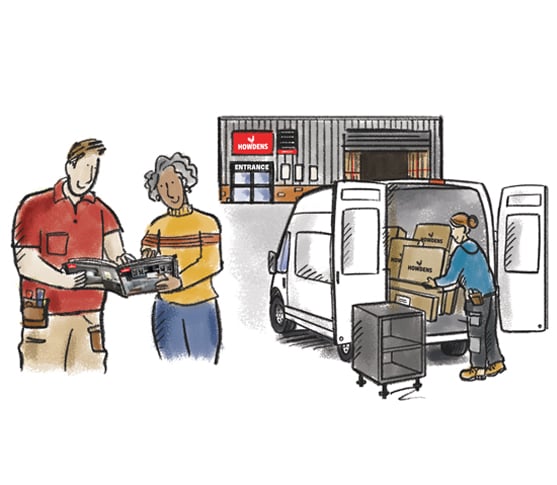
Business Model and Strategy
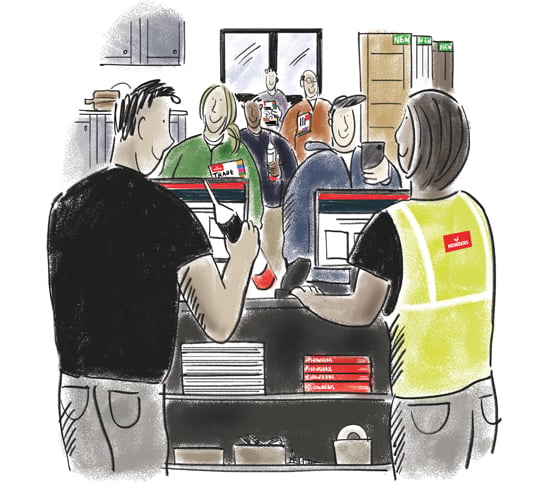
Depots
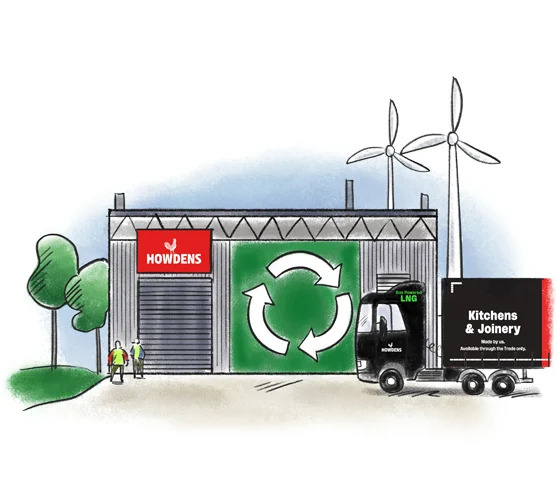
Sustainability
Community
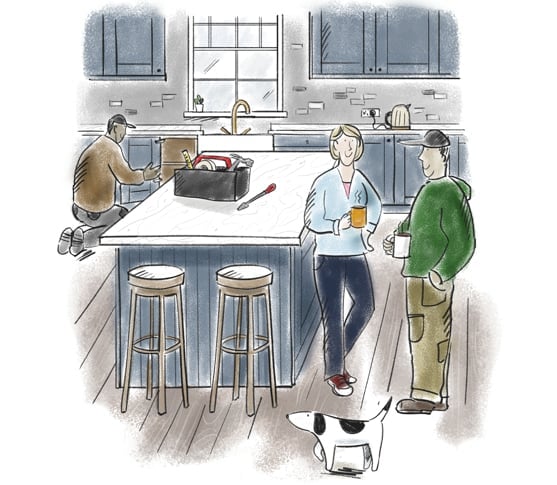
Products
People and Careers
